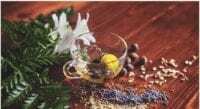
There are a number of fascinating subjects that the ancient practice of Ayurveda makes privy to us, most of them pertaining to our lives, mind and body alike. If you observe the creatures around you, then you would notice how particular animals are similar in nature with other animals belonging to their own species.
Humans are also considered social animals, but each individual differs in their physical, mental and cognitive behavior. You’ll encounter individuals who are agile and ripe with energy, and at the same time encounter those who embody stillness and calm. There are those who are overly enthusiastic and then there are those who can’t shed their despair.
Although, you might get answers to such discrepancies in human behavior in the theses published by modern science, Ayurveda has a much more compelling explanation to the idiosyncrasies and characteristics that are unique to us alone.
The Doshas
Ayurveda explains the peculiar nature of human existence by introducing us to the three Doshas that derive their definition from the five key elements of nature. These Doshas are aptly called Vata, Pitta and Kapha. The Doshas, as Ayurveda explains, are nothing but the biological energies that govern all the mental and physical endeavors of the human body, and reward us with our unique characteristics.
Our bodies are home to one or two of these Doshas, which in combination can have significant influence on our appearance and overall behavior. For e.g. a person with a strong ‘Vata’ constitution will reflect the mental and physical qualities attributed to Space and air. These individuals are blessed with fast thinking and a lean frame. People with a strong ‘Pitta’ constitution, on the other hand, will reflect the qualities of Fire and Water to exhibit a fiery personality and oily skin.
The Different Doshas
Vata Dosha
The Vata Doshas derives its constitution from the elements of Space and Air. The word ‘Vata’ literally translates to “that which moves with the winds”. Vata is deeply associated with the movement of force, and as such, gives motion to the other two doshas – Pitta and Kapha. It is widely known as the king of Doshas.
An individual with a balanced Vata can be characterized as someone who is open in expressing him or herself, someone who is active and also profoundly creative. An imbalance in Vata Dosha can occur when the wind in the Vata type is enraged. This can result in our bodies being flooded with negative qualities, and can exhibit physical and mental ailments like anxiety, constipation and dryness of skin.
A Vata individual will display physical and mental characteristics that are dry, cold, rough, mobile and subtle in nature. The Vata in a body can mainly be located in the colon, joints, thighs, bones, ear, brain, skin and nerve tissues. As such, Vata can govern bodily functions like muscle movement, food ingestion, menstruation, urination, creativity, communication, and flexibility.
Vata can be balanced by doing the following things consistently:
- Sleep early
- Meditate
- Follow a strict routine
- Commit to gentle exercises like swimming, walking, tai-chi and Yoga
Pitta Dosha
The Pitta Dosha derives its constitution from the elements of Fire and Water. The word ‘Pitta’ literally translates as “that which cooks”. Pitta is deeply associated with the energy of digestion, and metabolism that is undertaken by substances such as hormones, enzymes, organic acids and bile.
A ‘Pitta’ individual will exhibit physical and mental qualities such as sharpness, oily, liquid, acidic, light, hot and moving. The Pitta in a body can be located in the stomach, liver, pancreas, blood, liver, eyes and sweat. Physically, the Pitta governs the breakdown of complex food particles to provide the body with the energy it needs. While mentally, Pitta governs anger, joy, courage, willpower, perception and envy.
Pitta should be kept from becoming excess. Ayurveda dictates that it is our responsibility to always keep the eternal fire of our mind and body in check. An imbalance in Pitta can replace the positive feelings of joy, intellect and courage with negative emotions of rage, despair and ego.
A Pitta Imbalance can physically manifest itself in any individual in the form of an infection, inflammation, ulcers, heartburn and rashes.
You can balance your Pitta by doing the following things diligently;
- Have a Pitta balanced diet
- Meditate
- Engage in Soothing activities
- Engage in gentle exercises like yoga and tai-chi
Kapha Dosha
The Kapha Dosha derives its constitution from the elements of Earth and Water. The word ‘Kapha’ literally translates to “that which sticks”. Kapha is associated with the energy of lubrication and building. As such, it helps the body form its physical structure and aids in smooth functioning of all its parts. In simple words, Kapha can be defined as the glue that keeps our body from falling apart.
A ‘Kapha’ individual will exhibit physical and mental qualities such as sticky, static, moist, heavy, dull, cold and soft. The ‘Kapha’ in the body can be located in the chest, throat, ligaments, tissues, tendons, lymph and lungs. Physically, Kapha governs the lubrication of joints, moistening of food, storing of energy and cooling of bodily fluids whereas, mentally it governs love, greed, forgiveness, attachment and patience.
An imbalanced Kapha can result in our bodily tissues being flooded by bodily fluids, thus clouding our mind and weighing down our body. Physically, the imbalance in Kapha can manifest itself in the form of congestion, and obesity whereas mentally it can manifest itself in the form of depression, and lethargy.
You can keep your Kapha under check by doing the following things consistently:
- Avoid a luxurious lifestyle
- Have a balanced diet
- Introspect on your daily activities
- Sleep and rise early
- Don’t attach yourself to things
Obtaining the Appropriate Balance
The Doshas are in constant change pertaining to the actions we take. They are affected by the food we consume, the thoughts we possess, and the emotions we express. The fulfillment of our nature is what ultimately leads to the formation of our Doshas with respect to the lifestyle choices we make. As such, when we live a lifestyle that contradicts our very nature, our Doshas are imbalanced leading to great mental and physical distress.
There are three primary doshic states in which a body can exist:
- Balanced: Wherein all three doshas are present in equal proportions, thus achieving equilibrium.
- Increased: Wherein one dosha is greater than what is adequate for the body.
- Decreased: Wherein one dosha is lesser than what is adequate for the body.
Of all the three doshic states mentioned above, it is the ‘increased’ or ‘aggravated’ state that we should all be cautious of. An increased doshic state can cause great imbalance in the body, resulting in an array mental and physical ailments affecting the body. Hence, it is very imperative to understand one’s individual constitutional make-up. Only then can harmony between your mind and body be obtained for a blissful life.
What Is Your Dosha Type?
Ayurveda, also known as the science of life or knowledge is the only practice out there that specializes in individualized health care. It preaches methods and offers advise that help individuals attain a balanced doshic state. However, to achieve a balanced doshic state, you must first understand your mind-body dosha type. Luckily, we’ve got you covered. Fill in the Ayurveda Body-Type questionnaire available on our website and find out the Dosha type of your body now.
Note: The information in this article is intended for your educational use only and is not a substitute for professional medical advice, diagnosis, or treatment. Always seek the advice of your physician or other qualified health providers with any questions you may have regarding a medical condition and before undertaking any diet, supplement, fitness, or other health programs.





